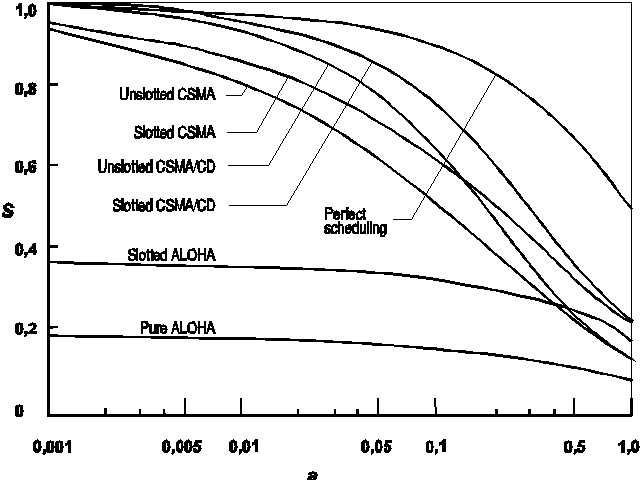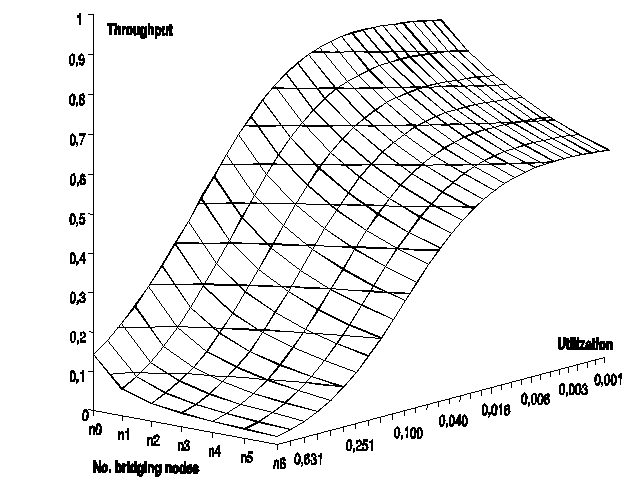
 |
JPL's Wireless Communication Reference WebsiteChapter: Network Concepts and Standards
|
HIPERLAN is a European (ETSI) standardization initiative for a HIgh PERformance wireless Local Area Network.
The tentative design parameters for HIPERLAN were:
Parameter |
Traffic Type |
Value |
| Data rate | asynchronous | 1 to 20 Mbit/s |
| time-bounded | 64 kbit/s to 2.048 kbit/s | |
| Systems throughput | 20 Mbit/s 1000 Mbit/s per hectare per floor | |
| Mean latency | asynchronous | <1 ms. (at 30% capacity) |
| Latency of service initiation | time-bounded | <3 S |
| MSDU Delay variance | asynchronous | no limit |
| time-bounded | <3.0 mS2 | |
| Range | to 50 m at 20 Mbit/s to 800 m at 1 Mbit/s |
|
| Area Coverage | 99.9% (single hop) | |
| Temporal Coverage | 99.9% (single hop) | |
| MPDU detected loss/error rate | <10-3 | |
| MPDU undetected loss/error rate | <8x10-8 per octet pf MPDU length | |
| MSDU undetected loss/error rate | <5x10-14 per octet of MPDU length | |
| Co-location tolerance | 50 cm of free space | |
| Mobility tolerance | 10 m/s linear, 360o/s angular | |
| Packet information field maximum size | 16 Kbytes | |
| Physical size target (excl. antenna system) | PC-Card (PCMCIA) type III (85x54x10.5 mm) | |
| Power consumption | few hundreds of mW |
The ETSI HIPERLAN Reference Model defines the components needed to build a Private Virtual Radio Sub-Network. Private in this context means user-owned and -operated. A Virtual Sub-Network is a logical subset of a set of communicating entities each of which is differentiated from the rest by some unambiguous identifier [Node Identifier or NID]. Virtual Sub-Networks are differentiated by an additional level of unambiguous identifier [HIPERLAN Identifier or HID].
Performance is one of the most important factors when dealing with wireless LANs. In contrast to other radio-based systems, data traffic on a local area network has a randomized bursty nature, which may cause serious problems with respect to throughput.
To give just a brief view of the problems we are faced with, we use HIPERLAN as an example. The following may be through for any radio-based LAN. HIPERLAN is, among other things, a MAC standard. This means that not only the "radio" operation of a HIPERLAN station, but also details on how to solve protocol-related issues like re-transmission, relaying and routing is covered.
HIPERLAN is designed to work without any infrastructure. Two stations may exchange data directly, without any interaction from a wired (or radio-based) infrastructure. The simplest HIPERLAN thus consists of two stations. Further, if two HIPERLAN stations are not in radio contact with each other, they may use a third station (i.e. the third station must relay messages between the two communicating stations). How this is done in practice we will deal with later. Figure 1 shows the relative throughput as a function of the relative network utilization, for various types of LANs.

| Figure 1 Throughput S as a function of relative utilization a for different network types |
It shows, that a slotted CSMA/CD scheme has the best over-all performance, while the ALOHA schemes has the poorest. In nature, a simple HIPERLAN between two stations that are in direct radio contact, will be an unslotted CSMA/CD system. In a system like that, the throughput S is given by:

where A is the probability of one station attempting to acquire the medium, and
Propagation delay time
a = -------------------------------
Transmission time of a packet
The number of stations, or networking nodes, between two communicating parties in a HIPERLAN affects the overall throughput of the network. Not only are the bridging nodes loaded with network traffic of their own, but also with pass-through traffic that requires path and route resolving. Depending on the processing capacity of the bridging nodes, throughput is reduced primary by transition delay. To overcome this, the data packet size at the MAC layer must be as large as possible, reducing the overhead per package routed through the HIPERLAN. If we assume, that the packet size is such that the delay caused by routing is 1/10 of the transmission time for each packet, the throughput for a HIPERLAN network consisting of two or more bridging nodes can be calculated. Figure 2 shows, that as long as the utilization of the network is low, the number of bridging nodes plays no significant role to the throughput, while when the utilization grows, a degradation of throughput is expected.

| Figure 2: Throughput in a HIPERLAN as function of utilization and the number of intermediate bridging nodes |
This result is not surprising. The question is, if it will be possible to define a MAC protocol that allows for large packets on one hand, and on the other hand may interface to existing LAN driver interface specifications such as NDIS or ODI. Further, another question is, if the assumption, that the transition delay in the forwarding nodes can be as little as 1/10 of the transmission time. At 16 Mbit/s and with an average package size of 8 Kbytes, the total transition time must be less than 4,1 mS which corresponds to about 200.000 CPU clock-cycles at 50 MHz.
Further one should have in mind, that HIPERLAN has been defined as bearer of both asynchronous and synchronous traffic. The consequence of mixing asynchronous and synchronous traffic on the same HIPERLAN is not yet known.